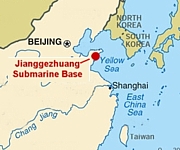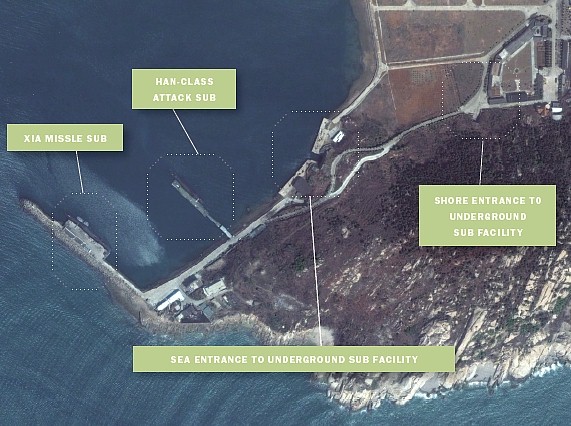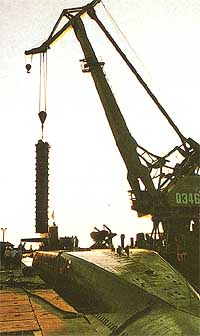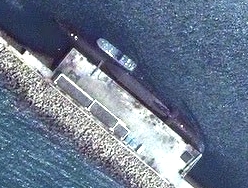Nuclear Brief February 16, 2006
 China's Nuclear Missile Submarine Base China's Nuclear Missile Submarine Base
The base for China's single Xia-class ballistic missile
submarine is located at Jianggezhuang approximately 15 miles (24 km)
east of Qingdao on the Yellow Sea (see map). The base spans an entire bay 1.2
miles (1.9 km) across, and includes six piers, a dry dock, numerous
service facilities, and an underground submarine tunnel. The main
facilities appear to be located in the eastern part of the bay. Apart
from the Xia, the base is also used by Han-Class nuclear attack
submarines.
|
Nuclear
Submarine Base at Jianggezhuang |
 |
The base for China's single Xia-Class
ballistic missile submarine is at Jianggezhuang near
Qingdao. In this satellite image taken by the Quickbird
satellite on April 19, 2004, the Xia SSBN and a Han-Class
attack submarine are moored near the entrance to an
underground submarine facility that presumably stores the
Julang-1 ballistic missiles and nuclear warheads for the
Xia.
Source: DigitalGlobe/"China's
Nuclear Forces,"
Imaging Notes, Winter 2006, p. 25. |
The most intriguing feature of the base is the
underground submarine facility located in the southeastern end of the
bay. The facility consists of a large submarine entrance from the
harbor, a pier side entrance to the south, and a land entrance to the
east (see image). The submarine entrance is approximately 43 feet (13
meters) wide and appears to be arched by a large concrete structure.
Both of the land-entrances are approximate 33 feet (10 meters) wide and
appear to have what may be a railway system connected to the interior of
the facility.
 |
The size of the underground submarine
facility at the Jianggezhuang Submarine Base is not known,
but the entrances give some idea of the possible outline. In
addition to a large submarine pool, the facility probably
houses storage facilities for ballistic missiles and nuclear
warheads for the Xia-class submarine.
Source: DigitalGlobe/ImagingNotes.com |
The size and layout of the underground
facility are unknown, but the entrances give some idea of what could be hiding
under the rocks. The submarine entrance likely extends at least a full Xia-class submarine length plus a little extra into the rock, and the
angle of the two entrances provide a hypothetical outline of the
facility (see image above). In addition to the submarine pool itself,
the facility might house storage facilities for the Julang-1
sea-launched ballistic missiles, storage facilities for the nuclear
warheads, and various personnel facilities. Moreover, rail tracks appear
to connect to outside buildings.
|
Pier Side
SLBM Loading |
 |
|
A Julang-1 SLBM is loaded into one of the Xia's
12 launch tubes. |
Although the underground facility is a possible storage
and service site for the Xia's nuclear Julang-1 medium-range ballistic
missiles, the submarine apparently can also onload the missiles at pier side. Several
images available on the Internet show the loading of Julang-1 missiles into the Xia using a large crain
(see right image).
The Xia submarine is equipped with 12 vertical launch tubes for
the Julang-1 medium-range ballistic missile. The 150 feet (47
meters) elevated hull behind the sail that houses the missiles is
clearly visible in the satellite image, which also shows a 90 feet (30
meters) boat moored alongside the Xia (see left image). The 12 hatches appear to span 80
feet (25 meters) of the elevated hull.
|
Xia SSBN At Jianggezhuang |
 |
The nuclear-powered ballistic missile submarine
Xia photographed at pier side on April 19, 2004.
Source:
DigitalGlobe/"China's
Nuclear
Forces,"
Imaging Notes, Winter 2006,
p. 25. |
The Xia submarine was launched in April 1981 and first
test fired a Julang-1 in October 1985. The Xia has never been fully
operational and has never conducted a deterrent patrol. From pier side
at Jianggezhuang, the submarine's 1,700 km range Julang-1 SLBMs are in
range of Okinawa but just short of Tokyo. Whether the submarine has the
capability to launch from pier side is unknown.
Jianggezhuang will likely also become the homeport for
China's Type 094-Class second-generation ballistic missiles submarine.
The first unit is under construction at the Huludao Shipyard
approximately 315 miles north of the base and may become operational
toward the end of the decade. The Type 094 will carry the Julang-2, a
modified version of the land-based DF-31 with a range of up to 8,000
kilometers. If the Type 094 design is successful, China will probably
build a few more in an attempt to establish a modest sea-based leg to
its nuclear posture.
While U.S. intelligence sources have been almost mute
about the submarine cave, the most extensive description about its
construction,
as pointed out by Jeff Lewis, was printed in John Wilson Lewis and Xue Litai's China's
Strategic Seapower (Stanford University Press, 1994, p. 123):
"In
February 1966, Mao, ever concerned to protect
the country’s defenses from air raids, urged the
navy to 'build more shelters' for its ships in
man-made caves. 'In building [such] shelters you
do not have to adopt underwater operations,' he
wrote. 'You can begin by digging a vertical
shaft just like the miners do. Then dig through
the rock horizontally to let seawater in. After
that, add a hardened cover over the shaft.' At
this, the navy embarked on a search for a place
where the nation might 'shelter its submarines.'
About two years later, Mao approved the navy’s
choice of an inlet near Qingdao. And ordered the building to commence.
The navy immediately transferred several
engineering regiments to work on the project’s
first phase, and they proceeded to remove 810,000
cubic meters of rock and to pour 200,000 cubic
meters of concrete. The gigantic sea cave
completed, construction crews then installed
17,000 pieces of equipment and laid 220 km
of pipeline, much of it related to
maintaining nuclear power plants. By the
mid-1970s, the concealed base was camouflaged
and hardened against attack and made ready to
receive the first nuclear boat, nuclear boat No.
401. In 1975, the navy authorized the North
China Sea Fleet to form the Nuclear Submarine
Flotilla.
The base comprises multiple
shelters, each of which has a number of
facilities to load and unload nuclear fuel
roads, move supplies,
monitor the performance of various subsystems,
repair breakdowns, and conduct demagnetization.
The cavernous shelter where the boats are docked
is as high as a 12-story building. Large-sized
cranes in this shelter can load or off-load the
JL-1 missiles. Partially protected against
nuclear or chemical attack as well as
conventional air raids, the shelters can
maintain communication and independent
operations under combat conditions. The base
commander can conduct effective command and
control of his submarines for extended periods
even when cut off from all outside support."
|

